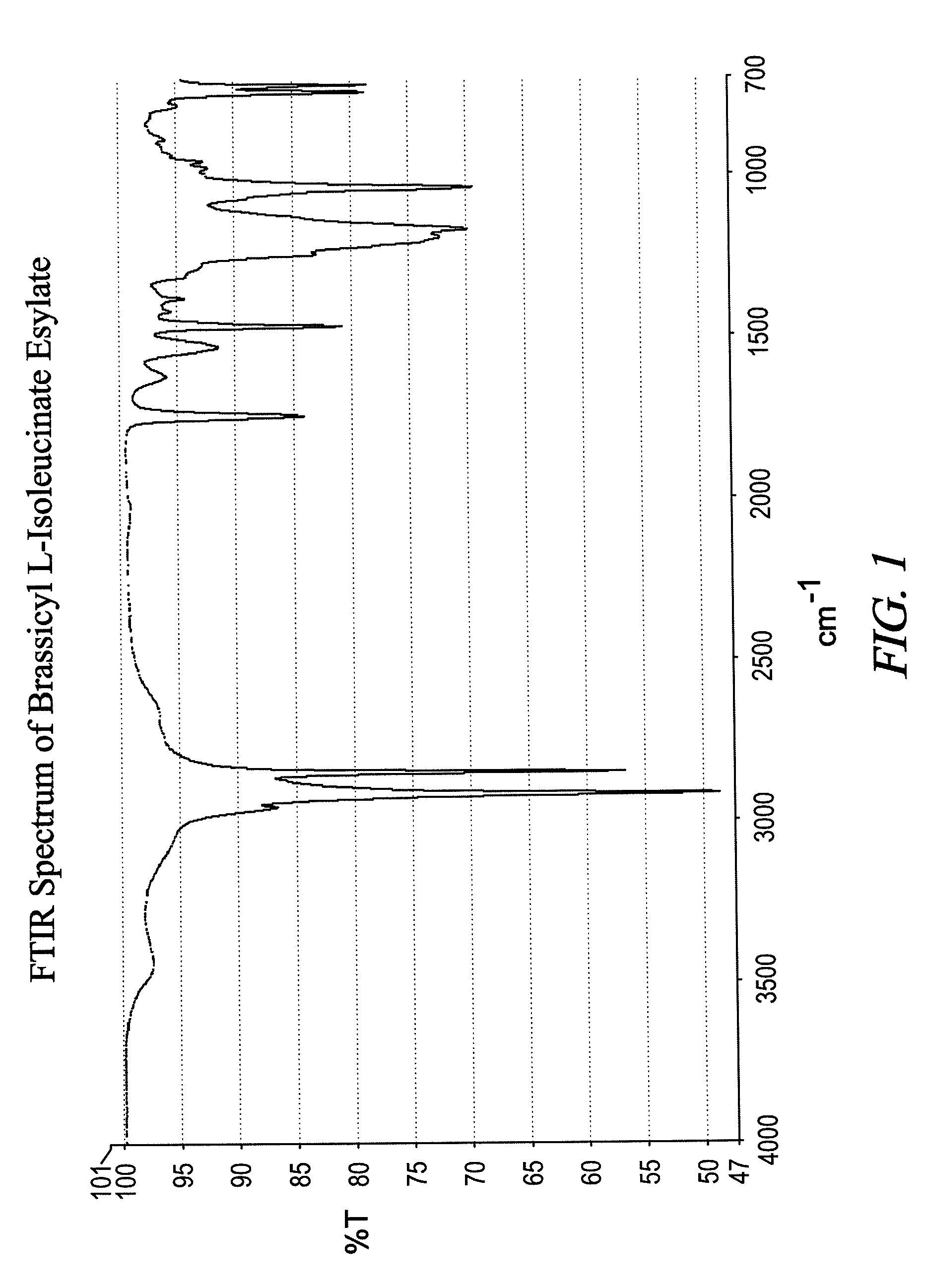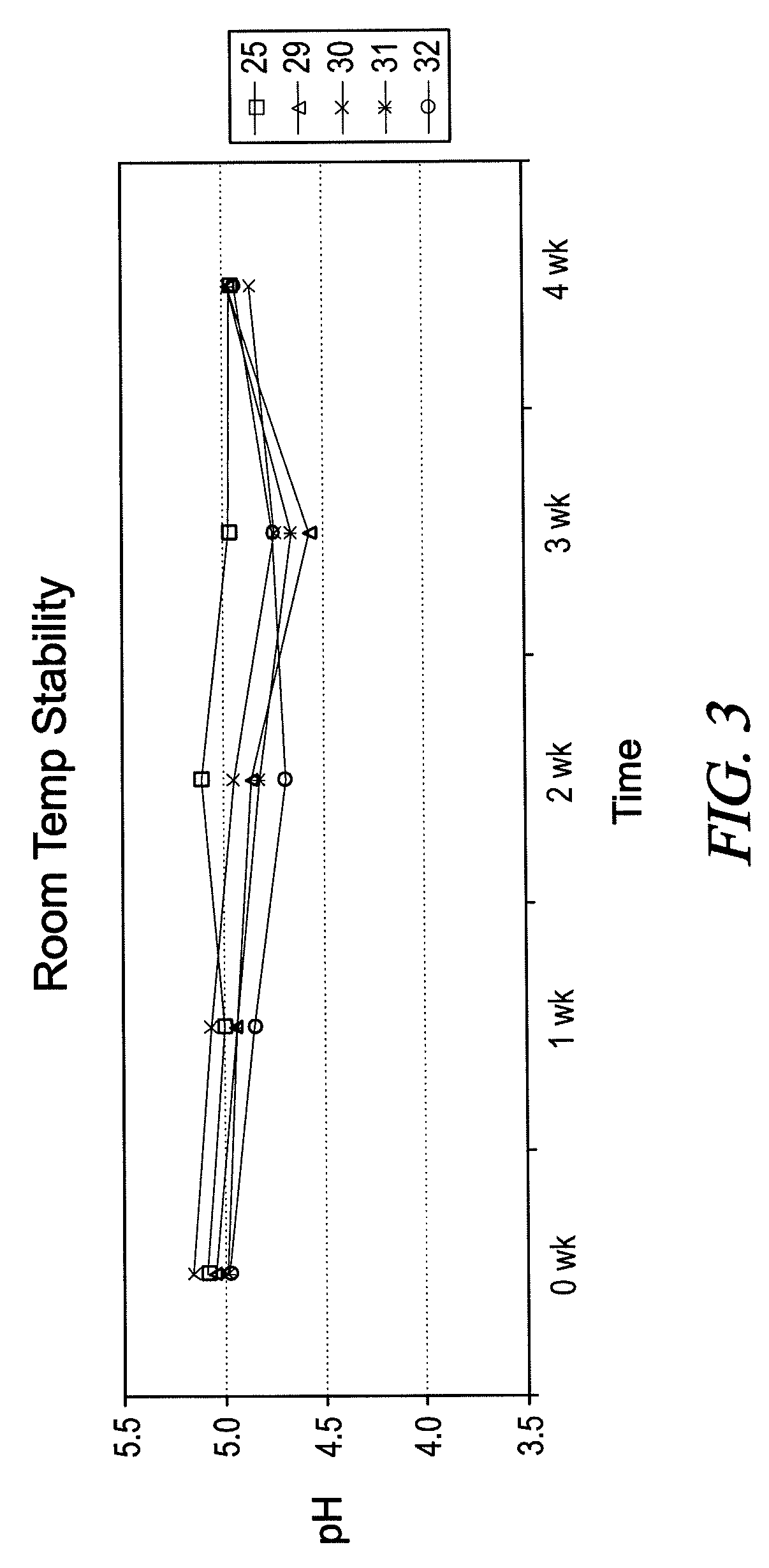Non-Petrochemically Derived Cationic Emulsifiers That are Neutralized Amino Acid Esters and Related Compositions and Methods
- Summary
- Abstract
- Description
- Claims
- Application Information
AI Technical Summary
Benefits of technology
Problems solved by technology
Method used
Image
Examples
example 1
Synthesis of Brassicyl L-Isoleucinate Esylate (BLIE)
[0055]To a one liter round bottom flask affixed with vapor column, total condenser, nitrogen sparge and agitator, 508.5 grams (1.629 moles) of Brassicyl alcohol and 106.9 grams (0.8147 moles) of L-isoleucine were charged. The mixture was warmed to 90° C. with stirring, and 134.5 grams (0.8551 moles) of a 70% solution of ethanesulfonic acid was added dropwise over about a twenty-minute period. The mixture was then heated to 140° C. and was held for about 16 hours. The mixture was then cooled to 90° C. and the excess of ethanesulfonic acid was neutralized with 1.8 grams of sodium carbonate dissolved in 5.6 grams of water. The mixture was then dried under hard vacuum for about one hour. The mixture was then cooled to about 70° C. and flaked off, yielding a pale yellow solid product.
[0056]Acid value was determined on the product using ASTM (American Society of Testing and Materials, West Conshohocken, Pa.) official method number D-972,...
example 2
[0057]Additional analogs of BLIE were prepared and analyzed using the general methods described in Example 1, and the properties are summarized in Table 1.
TABLE 1AmineValueAcid Value(mgMelting PointAmino AcidFatty Alcohol(mg KOH / g)KOH / g)(° C.)L-AlanineCoconut0.0106.678L-AlanineBrassicyl (Hyd.)3.471.999L-AlanineStearyl5.5114.6114 L-AlanineIsostearyl1.776.9Paste at R.T.L-ValineCoconut2.5109.0Paste at R.T.L-ValineBrassicyl (Hyd.)0.467.260L-ValineStearyl0.075.662L-ValineIsostearyl1.273.7Liquid at R.T.L-LeucineCoconut2.097.7Liquid at R.T.LeucineBrassicyl (Hyd.)3.565.462L-LeucineStearyl2.173.059L-LeucineIsostearyl1.872.1Liquid at R.T.L-IsoeucineCoconut5.3103.1Liquid at R.T.L-IsoeucineStearyl1.172.853
example 3
[0058]To demonstrate the emulsification behavior achieved by the present invention, an exemplary hair conditioning base formulation was prepared. The composition of the formulation is shown in Table 2.
TABLE 2Ingredients% w / wPart ADeionized water90.40L-Arginine0.20Part BStearyl alcohol5.90Brassicyl L-Isoleucinate Esylate3.50Total100.00
[0059]The formulation was prepared using the following procedure. Part A, deionized water and L-arginine were combined in a vessel with propeller agitation and heated to about 70 to about 75° C. and agitated until a clear solution was obtained. In a separate vessel, stearyl alcohol, cetyl alcohol, and Brassicyl L-isoleucinate esylate (BLIE) were combined and heated to about 70° C. to about 75° C., then agitated until a uniform mixture was obtained. The contents of the second vessel were added to the first, and agitated at a temperature of about 70 to about 75° C. until a milky dispersion was obtained (about 10 minutes.) The mixture was then allowed to c...
PUM
| Property | Measurement | Unit |
|---|---|---|
| Temperature | aaaaa | aaaaa |
| Temperature | aaaaa | aaaaa |
| Mass | aaaaa | aaaaa |
Abstract
Description
Claims
Application Information
 Login to View More
Login to View More - R&D
- Intellectual Property
- Life Sciences
- Materials
- Tech Scout
- Unparalleled Data Quality
- Higher Quality Content
- 60% Fewer Hallucinations
Browse by: Latest US Patents, China's latest patents, Technical Efficacy Thesaurus, Application Domain, Technology Topic, Popular Technical Reports.
© 2025 PatSnap. All rights reserved.Legal|Privacy policy|Modern Slavery Act Transparency Statement|Sitemap|About US| Contact US: help@patsnap.com



